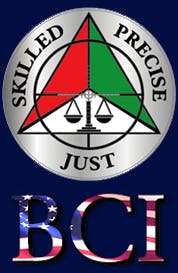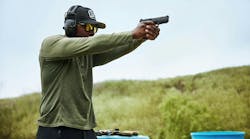As I ponder, each week, what I'm going to review for Officer.com, I try to make sure that I'm not saturating the reviews with related articles. I also take a look back at what I have reviewed in the past that might need follow up. In looking back I realized that I've got a lot of information about Emerson Knives but haven't shared any of it since 2003. Having discovered that, and having a collection of Emerson knives that I tend to rely on fairly regularly, I figured it was time to revisit them. So this week we're going to take a look at Emerson's Commander, CQC7, SpecWar, and others.
Back in '03 I had some kind things to say about the three Emerson knives already listed: the Commander, CQC 7 and SpecWar. None of that has changed. These knives are still often carried by either myself or my wife and the Commander especially remains one of my favorite folders. It was the first knife with the Wave feature I experienced and I really appreciate two things about the knife: the shape of the blade and the overall thickness of the knife when it's closed. I appreciate the common hardware used in the construction that allows me to completely disassemble this knife if necessary for cleaning or other maintenance.
The CQC-7 that I wrote up in '03 had been my wife's daily carry knife and she put it through a lot of use and abuse... until she broke the tip using it as a pry bar. Since then, I've had the tip fixed and kept the knife (she's not getting it back). I like the Tanto-style blade of the CQC-7 and often use it for a duty carry blade. The overall design doesn't feel as rounded or artistic as some other Emersons...it just feels more utilitarian to me. I should note that the clip on the CQC-7 I have is reversible, even though the knife is designed as a right-handed knife: the thumb notch grooved into the handle to allow access to push the liner lock aside is set up for manipulation by a right handed person.
SpecWar
The SpecWar I have actually has black handles instead of the green shown here. Take a look at the differences between the CQC-7 and the SpecWar. Both have Tanto-style blades but the forward section of the spine on the SpecWar has a slightly more aggressive angle. The grips on the SpecWar are just a little more ergonomic than those of the CQC-7. Both feel comfortable in my hand, but I think of it this way: if I lined up the CQC-7 followed by the SpecWar and then the Commander, the SpecWar would almost serve as a middle model for the CQC-7 being converted into the curved smooth ergonomic comfort of the Commander.
A knife that I have recommended to a number of people is the Emerson Law Enforcement SARK (search and rescue knife) model. For the uneducated, this knife looks much less aggressive and is obviously designed for rescue work. It could never be used as a defensive weapon, right? Just look at that nice rounded tip and the curve of the spine that specifically allows this knife to be used to cut away webbing, clothing or anything else that might be binding or trapping a victim. It's a knife that is easy to defend possession of for cops. Now let your imagination work just a tad and understand that the knife can also be used as a defensive tool and would serve that function well. The curve of the blade in relation to the handle is similar to that of a karambit design. Hmmm...If you ARE going to use this as a duty knife, I'd recommend the plain edge instead of the combo edge that has partial serrations. The serrations make it easier to cut cord, rope, etc, but from what local rescuers tell me, cutting through clothing is much easier with the plain edge.
CQC-10
This brings me to a new knife Emerson has introduced: the CQC-10. As I mentioned earlier about an evolutionary progression from CQC-7 to SpecWar to Commander, I'd have to include the CQC-10...right after the SpecWar and before the Commander. Check the grip ergonomics and the blade. Gone is the Tanto-style blade, but not yet existent is the deep belly curve of the Commander. This no-nonsense folder offers the best of several worlds. The blade is perfectly functional for utilitarian use, but because of the tip design can also be easily deployed for rescue purposes. The grips are nicely shaped to insure a secure hold even under wet or slippery conditions. The lanyard hole, as with all Emerson knives, means you can tie the knife onto your gear someplace--especially if you happen to be working in a maritime environment.
CQC-15
That brings me to the last knife of the review: the CQC-15, which I'd have to put in between the SpecWar and the CQC-10 on the Emerson Knives evolutionary scale. The Tanto-style blade isn't fully apparent here--but neither is it completely non-existent. The partial Tanto style allows for strong blade tip strength and the soft curve provides for better cutting power when pressing into cuts. The soft belly curve found in the Commander is just starting to be seen in the CQC-15 and the grips are shaped well for a secure hold.
If I were to go shopping today for a new folder and had to select from the Emerson collection covered here I'd have to make some hard choices. I already have the Commander, CQC-7 and SpecWar. Which of the other three to buy? Hmmm...



